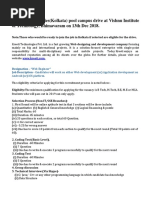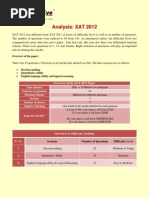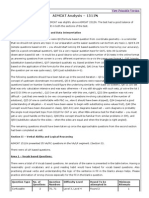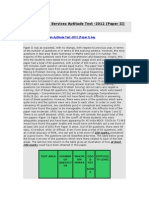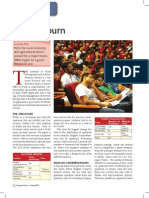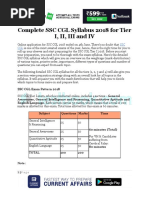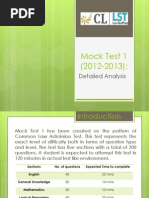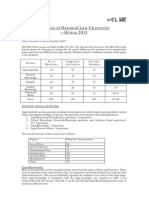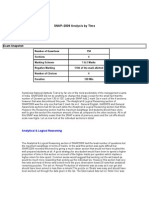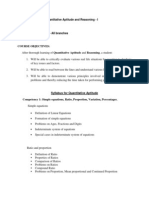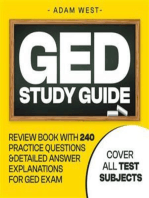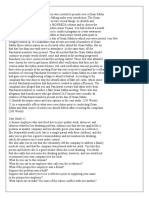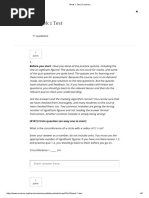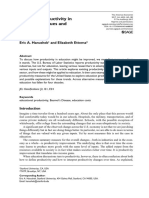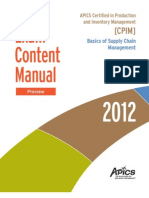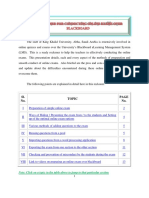SNAP 2013 Analysis
SNAP 2013 Analysis
Uploaded by
AchyutPareekCopyright:
Available Formats
SNAP 2013 Analysis
SNAP 2013 Analysis
Uploaded by
AchyutPareekOriginal Description:
Copyright
Available Formats
Share this document
Did you find this document useful?
Is this content inappropriate?
Copyright:
Available Formats
SNAP 2013 Analysis
SNAP 2013 Analysis
Uploaded by
AchyutPareekCopyright:
Available Formats
SNAP 2013 Analysis
The LEADER in Online Test Prep
The SNAP 2013 exam was similar to SNAP 2012 in terms of difficulty level, except for the General Awareness
section which predominantly comprised static GK (like 2011). The overall structure and marking scheme of
the exam was the same as the last few years i.e. 150 questions for 180 marks in 120 minutes. As usual, the
Logical Reasoning section had the least questions but the maximum marks allotted to it.
Summary
Number of Sections
Options per Question
Negative Marking
1/4th of Marks for the Question
2 per question for LR, 1 per question for
remaining sections
Marks per Question
Expected Overall Cut-offs
110+ for SIBM-P, 105+ for SCMHRD
1. Logical Reasoning 30 questions:
Like every year, the LR section had 30 questions, with 2 marks allotted to each question. The concepts
covered in this section were linear and complex arrangements, coded relationships, cubes, coded
mathematical operations, letter and number coding, Venn diagrams, analogies, number series, syllogisms
etc. Unlike previous SNAP exams, there were no critical reasoning questions in this section this year. The
question level breakup of questions is as given below:
SNAP 2013 Analysis
Question Type
Number of Questions
Relationships - Coded
Directions
Linear Arrangements
Complex Arrangements
Number Series
Letter Coding
Number Coding
Odd Man Out
Coded Mathematical Operations
Venn Diagrams
Cubes
Diagrammatic Numeric Puzzle
Miscellaneous puzzle
Syllogisms
Tables and Caselets
Clocks
www.TestFunda.com
SNAP 2013 Analysis
The LEADER in Online Test Prep
In general, the entire section was simple but the order in which you attempted questions could have
helped optimise your available time. The two sets on Venn diagrams (Indians, Americans as well as
Sachin, Sourav and Dhoni) and complex arrangements (people, day and dish) were quite simple and could
have attempted quickly. The set on people and amounts was easy, provided it was solved using answer
options. If solved conventionally, it would have taken some more time. The single questions should have
been attempted based on the students comfort level and time available. There were two DI sets as well,
out of which, the set on 6th, 7th and 8th plan was very simple. On the whole, a student could have attempted
23-25 questions in around 40 minutes with a very high accuracy.
2. Verbal Ability 40 questions:
This years SNAP did not differ much from previous SNAP papers.
Question Type
Number of Questions
Reading Comprehension
Vocabulary Synonyms, idioms, odd
man out, spellings
7
15
Fill in the blanks
Faulty Construction
Mark the error
Jumbled sentences
Parts of Speech
The verbal section laid heavy emphasis upon the vocabulary, fill in the blanks and grammar question
types. The vocabulary based questions tested concepts pertaining to synonyms, idiomatic usage, spellings
and odd man out. Although fill in the blanks tested grammar applications, there was an emphasis on
vocabulary. The grammar based questions that required one to select errors were fairly simple.
The paper comprised two RCs. One of the RCs was based on ill-temper and had four questions out of
which two were passage based and two vocabulary-based. Although the subject matter was dense, the
questions were very easy. The other RC was based in the context of slavery and had 3 passage based
questions, which once again were rather simple.
There were two questions based on jumbled sentences. While one had five sentences that were to be
rearranged, the other had a single sentence jumbled into nine segments. Using options, both questions
could have been attempted successfully.
Overall the difficulty level of this section was easy to moderate. 31-33 attempts in 30 minutes would have
been a good attempt.
3. General Knowledge and Current Affairs 40 questions:
The GK section was a mixed bag, covering topics from business, international organisations, sports,
politics, history, science etc. However, unlike last year, there were hardly any questions on current affairs.
Also, there was greater emphasis on questions from banking, economics and finance. A well-read student
could have easily attempted 15-17 questions in this section.
SNAP 2013 Analysis
www.TestFunda.com
SNAP 2013 Analysis
The LEADER in Online Test Prep
4. Quantitative Ability + Data Interpretation 40 questions:
The Quantitative Ability section was extremely easy with a very high focus on Arithmetic (approximately
60% of the section). A feature of this section was that while it was called the QA+DI+DS section, there
were no DS question in the exam and the DI questions were asked in the LR section.
The overall topic-level breakup of this section is as given below:
Topic
Number of Questions
Averages
Percentages
Interest and Growth Rates
Profit, Loss and Discount
Ratio and Proportion
Mixtures and Alligation
Time and Distance
Time and Work
Triangles
Number Theory
Surds and Indices
Logarithms
Mensuration
Sequences, Progressions & Series
Permutations & Combinations
Venn Diagrams
Within Arithmetic, the focus was on time and distance, time and work, percentages, profit and loss, ratio
and proportion and averages. In algebra, numbers (LCM), surds and logarithms (basic properties) were
covered while Geometry had questions on triangles (similarity, angles) and mensuration (property of
perimeter and area). There was a question on multiple ratios which could have been solved easily by
expressing the ratios as a series. There were also a couple of easy P & C questions based on the basic
principle of counting and a couple of two-figure Venn diagram questions. 17-18 questions were extremely
simple. There were only 6-7 questions that could be classified as time consuming and slightly difficult.
The set of 3 questions on tunnel, jackal and cat could have been avoided. On the whole, this was a simple
and high-scoring section. A student could have easily attempted 28-32 questions in around 35 minutes.
Overall, 95+ attempts and a score of 110 or above should be a good score for students applying to SIBM
(Pune). For students applying to SCMHRD, 105 or above should be a safe score. The cut-offs should be
lower for the remaining Symbiosis institutes.
SNAP 2013 Analysis
www.TestFunda.com
You might also like
- 360 Final CBC JapaneseDocument74 pages360 Final CBC JapaneseJoana Boadilla100% (3)
- Cambridge Vocabulary Activities - CompleteDocument112 pagesCambridge Vocabulary Activities - CompleteCal Varium88% (8)
- MLO HandbookDocument33 pagesMLO HandbookAnthony Navas100% (1)
- Kreeti Technologies (Kolkata)Document3 pagesKreeti Technologies (Kolkata)tejakandula59% (17)
- SNAP 2012 Analysis: 1. Logical Reasoning - 30 QuestionsDocument3 pagesSNAP 2012 Analysis: 1. Logical Reasoning - 30 QuestionsAchyutPareekNo ratings yet
- Snap 2009 AnalysisDocument5 pagesSnap 2009 Analysisimaginer88No ratings yet
- Pgcet PatternDocument5 pagesPgcet PatternVivekananda MgNo ratings yet
- UPSC Prelims 2013 Analysis: Paper I - GSDocument0 pagesUPSC Prelims 2013 Analysis: Paper I - GSrajputrulesNo ratings yet
- IIFT 2010 Analysis: Exam OverviewDocument0 pagesIIFT 2010 Analysis: Exam OverviewAjeet Singh RachhoyaNo ratings yet
- Analysis: SNAP 2012: Overview of Different SectionsDocument2 pagesAnalysis: SNAP 2012: Overview of Different SectionsKaranwadhwaNo ratings yet
- Feedback On CET 2014 - First Day First Slot AnalysisDocument3 pagesFeedback On CET 2014 - First Day First Slot AnalysisSameer PandeyNo ratings yet
- IIM Lucknow WPM Program Analysis: English and Verbal Ability: Topic No. of Questions Overall Difficulty Good AttemptDocument1 pageIIM Lucknow WPM Program Analysis: English and Verbal Ability: Topic No. of Questions Overall Difficulty Good AttemptRupesh KaushikNo ratings yet
- CMAT Sep 2014 Analysis: 1. Quantitative Techniques and Data InterpretationDocument2 pagesCMAT Sep 2014 Analysis: 1. Quantitative Techniques and Data InterpretationHitisha agrawalNo ratings yet
- Detailed Analysis and Strategy For SnapDocument5 pagesDetailed Analysis and Strategy For SnapMichael GeorgeNo ratings yet
- 1-CAT The Changing TrendDocument5 pages1-CAT The Changing Trendmanishsavalia09No ratings yet
- TISS Analysis 2014Document2 pagesTISS Analysis 2014deepikaNo ratings yet
- Mrunal (Studyplan) UPPCS Preliminary Exam Paper 2 - Aptitude, Maths, Reasoning, Decision Making, English, Hindi, Free Studymaterial & Previous Papers Print PDFDocument15 pagesMrunal (Studyplan) UPPCS Preliminary Exam Paper 2 - Aptitude, Maths, Reasoning, Decision Making, English, Hindi, Free Studymaterial & Previous Papers Print PDFrockstar104No ratings yet
- SNAP 2023 - Mock 1 AnalysisDocument2 pagesSNAP 2023 - Mock 1 AnalysisGeorge FloydNo ratings yet
- Ibps Po Cwe 2014 AnalysisDocument2 pagesIbps Po Cwe 2014 AnalysisKarthick SureshNo ratings yet
- Analysis: XAT 2012: Overview of The PaperDocument3 pagesAnalysis: XAT 2012: Overview of The Paperrockstar104No ratings yet
- What To Expect in AFCAT ExamDocument5 pagesWhat To Expect in AFCAT Examlolu pandeyNo ratings yet
- J Met 2010 AnalysisDocument4 pagesJ Met 2010 AnalysisThahir NmNo ratings yet
- Tiss 2Document3 pagesTiss 2grlinblujeansNo ratings yet
- Results Analysis NewDocument4 pagesResults Analysis NewRajgopal BalabhadruniNo ratings yet
- Csat 2012 Paper2 AnalysisDocument8 pagesCsat 2012 Paper2 AnalysisJaiGaneshNo ratings yet
- Cat Corner 2Document2 pagesCat Corner 2Nisha Agarwal 3No ratings yet
- Detailed IBPS RRB Syllabus For Prelims 2017 - Officers & Office AssistantDocument10 pagesDetailed IBPS RRB Syllabus For Prelims 2017 - Officers & Office AssistantThomas JoseNo ratings yet
- Dip Prioirty Goals - 2013-2015Document3 pagesDip Prioirty Goals - 2013-2015api-272533157No ratings yet
- Xat AnalysisDocument4 pagesXat AnalysisManoj MoparthiNo ratings yet
- Mathematics Tests in Pisa 2003: © Tünde KDocument8 pagesMathematics Tests in Pisa 2003: © Tünde KMarcial HsNo ratings yet
- Detailed SBI PO Syllabus and Guide Prelims 2017Document12 pagesDetailed SBI PO Syllabus and Guide Prelims 2017Sindeesh DineshNo ratings yet
- Section Number of Questions MarksDocument2 pagesSection Number of Questions MarksVivek GusaniNo ratings yet
- Complete SBI PO Syllabus and Guide For Prelims 2018 - Download As PDF!Document13 pagesComplete SBI PO Syllabus and Guide For Prelims 2018 - Download As PDF!YashWant DonGe ThaKurNo ratings yet
- Complete SBI PO Syllabus and Guide For Prelims 2018 Download As PDFDocument13 pagesComplete SBI PO Syllabus and Guide For Prelims 2018 Download As PDFRohan NakasheNo ratings yet
- #1. Exam Pattern For SBI PO 2017 PrelimsDocument8 pages#1. Exam Pattern For SBI PO 2017 PrelimsSri Krishna KumarNo ratings yet
- Bank PO-CWE Analysis 2011: Test PrepDocument5 pagesBank PO-CWE Analysis 2011: Test PrepSharad SrivastavaNo ratings yet
- Ibps Cwe (Po) June2012 AnalysisDocument0 pagesIbps Cwe (Po) June2012 Analysisbhavk20No ratings yet
- Complete SSC CGL Syllabus 2018 For Tier I, Ii, Iii and IvDocument14 pagesComplete SSC CGL Syllabus 2018 For Tier I, Ii, Iii and IvKenny CharlesNo ratings yet
- Data Sufficiency Importance of Data Sufficiency in Various ExamsDocument5 pagesData Sufficiency Importance of Data Sufficiency in Various Examstanima0% (1)
- Mat May 2012 Exam AnalysisDocument9 pagesMat May 2012 Exam AnalysisRam AnjaneyuluNo ratings yet
- Analysis of XAT 2005Document4 pagesAnalysis of XAT 2005Tejashwi KumarNo ratings yet
- SNAP 2023 - Mock 3 AnalysisDocument3 pagesSNAP 2023 - Mock 3 AnalysisGeorge FloydNo ratings yet
- Detailed IBPS PO Mains Syllabus and Study MaterialDocument19 pagesDetailed IBPS PO Mains Syllabus and Study MaterialNaveen KumarNo ratings yet
- IIFT - 2014 Analysis & Key-TIMEDocument2 pagesIIFT - 2014 Analysis & Key-TIMElucifer1711No ratings yet
- Mock Test 1 Detailed AnalysisDocument17 pagesMock Test 1 Detailed AnalysisKashishShNo ratings yet
- Tiss AnalysisDocument3 pagesTiss AnalysisManoj MoparthiNo ratings yet
- NABARD 15 Pre-Exam AnalysisDocument4 pagesNABARD 15 Pre-Exam AnalysisAshwani RanaNo ratings yet
- XAT2009 AnalysisDocument4 pagesXAT2009 AnalysisNips008No ratings yet
- SBI PO Syllabus and Guide Prelims 2016Document12 pagesSBI PO Syllabus and Guide Prelims 2016Naveen KumarNo ratings yet
- SSC CGL Syllabus 2018 19 For Tier I II III and IV 67001c22 PDFDocument15 pagesSSC CGL Syllabus 2018 19 For Tier I II III and IV 67001c22 PDFumeshNo ratings yet
- Detailed Syllabus For IBPS PO Prelims With Online Resource GuideDocument13 pagesDetailed Syllabus For IBPS PO Prelims With Online Resource GuideGg KNo ratings yet
- Bank SBI Main Exam 2011 AnalysisDocument3 pagesBank SBI Main Exam 2011 AnalysisSourabh SharmaNo ratings yet
- Csat Jan 2011Document39 pagesCsat Jan 2011Dr. Vinod GuptaNo ratings yet
- Analysis of National Law University - Orissa 2011Document4 pagesAnalysis of National Law University - Orissa 2011Pranjal KalantriNo ratings yet
- GATE Solved Question Papers For Physics PH by AglaSem Com PDFDocument53 pagesGATE Solved Question Papers For Physics PH by AglaSem Com PDFrhythm100% (1)
- SNAP-2009 Analysis by TimeDocument4 pagesSNAP-2009 Analysis by TimeSushant BhartiNo ratings yet
- QuantitativeDocument9 pagesQuantitativeRavi RanjanNo ratings yet
- TISS Entrance For Master's.Document7 pagesTISS Entrance For Master's.vaibhavi sharma pathakNo ratings yet
- GED Study Guide: Review Book with 240 Practice Questions and Detailed Answer Explanations for GED Exam (Covers All Test Subjects)From EverandGED Study Guide: Review Book with 240 Practice Questions and Detailed Answer Explanations for GED Exam (Covers All Test Subjects)No ratings yet
- Ibps AnalysisDocument6 pagesIbps Analysissuresh1852No ratings yet
- Prospectus S de 2017Document70 pagesProspectus S de 2017nitroboozterNo ratings yet
- Case 11Document4 pagesCase 11Firoz ShirpurkarNo ratings yet
- Punjab Food Inspector Sample PaperDocument4 pagesPunjab Food Inspector Sample PaperSarbjit SinghNo ratings yet
- Law and Contract Management Curriculum 2019 20Document57 pagesLaw and Contract Management Curriculum 2019 20chong pak limNo ratings yet
- Classroom Orientation GuideDocument10 pagesClassroom Orientation Guidecindy juntongNo ratings yet
- Syllabus of DisMath (Online - Offline Format) 2021-2022Document8 pagesSyllabus of DisMath (Online - Offline Format) 2021-2022Mars MercuryNo ratings yet
- Week 1 TestDocument8 pagesWeek 1 TestJISU KIMNo ratings yet
- SG Certified Sales Cloud ConsultantDocument8 pagesSG Certified Sales Cloud ConsultantAnkush DurejaNo ratings yet
- SLST Brochure 0912 2016Document16 pagesSLST Brochure 0912 2016Stephen GreenNo ratings yet
- Cambridge IGCSE: Computer Science 0478/22Document2 pagesCambridge IGCSE: Computer Science 0478/22Zaid NabulsiNo ratings yet
- Sbi Junior Associate Syllabus PDFDocument4 pagesSbi Junior Associate Syllabus PDFanon_789699787No ratings yet
- Unit Plan For FadoDocument8 pagesUnit Plan For Fadoapi-309578782No ratings yet
- LL 1 B 3 Year LLM 2 Year Prospectus-11-12Document56 pagesLL 1 B 3 Year LLM 2 Year Prospectus-11-12rpviteshNo ratings yet
- Final Assessment AnswerDocument2 pagesFinal Assessment AnswerSarah Imarah MislangNo ratings yet
- CDS 1 English 2011 PDFDocument24 pagesCDS 1 English 2011 PDFMaitra RaginiNo ratings yet
- Board of West Bengal SyllabusDocument4 pagesBoard of West Bengal Syllabusapi-139761950No ratings yet
- Printable Final PSN BookletDocument6 pagesPrintable Final PSN BookletfarooqNo ratings yet
- Defining Productivity in Education: Issues and IllustrationsDocument19 pagesDefining Productivity in Education: Issues and IllustrationsprakashvasanthamNo ratings yet
- Open Book: Production Planning and Inventory Control TIN 323Document3 pagesOpen Book: Production Planning and Inventory Control TIN 323rifqi rahmanNo ratings yet
- Exam Content Manual: (CPIM)Document4 pagesExam Content Manual: (CPIM)Jonathan BrasNo ratings yet
- Mumbai University Courses PDFDocument261 pagesMumbai University Courses PDFMohammad ChawreNo ratings yet
- Class Policy 322Document12 pagesClass Policy 322Charles DiggsNo ratings yet
- Ready Reckoner For Conducting Online ExamsDocument13 pagesReady Reckoner For Conducting Online ExamsAmanullahNo ratings yet
- 6th Exam Time TableDocument21 pages6th Exam Time TableSunil ChoudhariNo ratings yet
- Istqb QuestionsDocument53 pagesIstqb QuestionsSundaresan NatarajanNo ratings yet
- Fce Writing Part 2 Short Stories ActivityDocument7 pagesFce Writing Part 2 Short Stories Activityhenniebennie0% (1)



